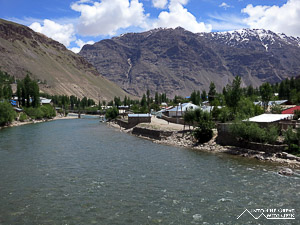Khorog, Tajikistan
The Pamir Highway Part II - Back to Civilization
May 22, 2012
I have all I want is that simple enough
There's a whole lot more I'm thinking of
- Crowded House

Thankful to leave the isolated outpost of Murgab behind, I continued west along the Pamir Highway toward Khorog. My companions in the shared car included five Tajikistan customs agents from Dushanbe and another local man. The Tajik customs agents have the job of inspecting vehicles passing through to neighboring countries. Due to its long and remote border with Afghanistan, Tajikistan is one of the main corridors for smuggling heroin from Afghanistan to the American and European markets. Around 80% of the world’s heroin supply comes from the Afghan poppy fields, just across the border in the northern regions, and what doesn’t pass through Tajikistan finds its way out through Pakistan or Iran. This was just a reminder that as remote as this region seems it still has its connection to the problems of the rest of the world. But pulling out of Murgab, it wasn’t long before we had left civilization and any of those problems behind us and entered the emptiness of the Pamir Mountains.
Within about 30 minutes the sunny weather faded into a low lying fog and it started to snow. With so little traffic on the road the visibility wasn’t a problem but for observing the scenery it certainly was. Over the last few hundred kilometers of this high altitude terrain I knew what to expect anyways, arid landscapes of rock and dirt with snowy peaks at the greater heights.

With our late start to the journey we stopped for lunch during the snowstorm at the bleak village of Alichur with its lone yurt and small collection of houses. I remarked how there was absolutely nothing here and the Tajik customs agents said, in a slightly derogatory manner, that only the Kyrgyz people lived up here. Lunch was again soup and bread but this time also fried fish from some local lake and manti, meat filled dumplings. After lunch the customs agents decided it was time for shots of vodka in the car, fortunately for all of us the driver did not accept the shots he was offered.
Several minutes outside of Alichur the snow storm worsened and we were driving through a near total blizzard, but again there was no traffic on the road so it mattered little. The storm began to subside as we crossed a high plain and the greenish waters of lake Yashil Kul emerged, surrounded by desert landscape. The fog persisted as we arrived at Jelandy, site of a collection of hot springs enclosed in primitive bath houses. With the cold and dreary weather the hot water was refreshing, equally so for me after sleeping on floors and some days without hot water or any running water for that matter.

When everyone was finished with the hot springs the weather had cleared and we started the last stretch of the road toward Khorog. Here the elevation dropped and we started to re-enter places that were actually hospitable towards human life. The desolate rocky snow covered mountains and open plains transitioned to colored cliffs and villages beside the clear blue-green Gunt River. Rickety footbridges crisscrossed the river, providing access to houses on each bank while human, vehicle, and animal traffic picked up along the main road. The final section of the road before Khorog passed through a series of half tunnels on a mountainside designed to protect the road from frequent rockslides and avalanches.
Khorog was unlike anything I had expected after my time in China, Kyrgyzstan, and eastern Tajikistan. The lower elevation gives it a pleasant climate and the warm sunshine lights up the steep valley with dazzling views of the red rock canyons and snow covered mountains in the distance. The town itself has a very relaxed atmosphere and seems to be a big student town with the presence of a campus of the Central Asian University. There is a nice central park by the river where children play on a playground and other people stroll or sit beneath the leafy trees on manicured grounds. The main street runs parallel to the river and leads to a rag tag bazaar with some enclosed sections in old Soviet buildings and a more lively outdoor section with dirt alleys and makeshift vendor stalls. From the presence of a large youth center and other buildings you can see the presence of foreign aid money here.

The people on the streets are an amazingly diverse mix of women dressed in modern western fashions or some in more traditional colored robes, kids in soccer clothes, men in business suits, students in t-shirts, jeans, and sunglasses. In general they couldn’t look more different than the people I saw in nearby regions of Kyrgyzstan or across the border in China. You can see the influence of the Persian heritage in the looks of the people and in the sounds of the language. The Tajik language and the local dialects here are rooted in Persian but use the Cyrillic alphabet with a few additional characters, and though I can read the words they are very different and I can make no sense of them. But for a place, culture, and people that seem so foreign it is remarkably pleasant and in some strange way I almost feel at home.































































